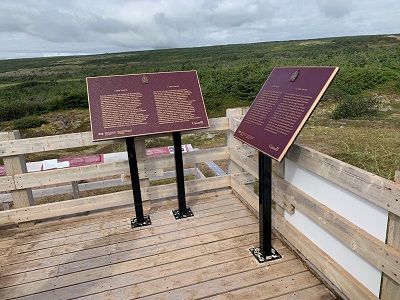L'Anse Amour National Historic Site of Canada
L'Anse-Amour, Newfoundland and Labrador

Bilingual HSMBC plaque, Innu-Aimun and Inuttitut
© Parks Canada | Parcs Canada, 2023.
Address :
L'Anse-Amour, Newfoundland and Labrador
Recognition Statute:
Historic Sites and Monuments Act (R.S.C., 1985, c. H-4)
Designation Date:
1978-06-19
Event, Person, Organization:
-
Maritime Archaic People
(People, group)
Other Name(s):
-
L'Anse Amour
(Other Name)
-
L'Anse Amour Burial
(Other Name)
Research Report Number:
1978-SUA, 2005-SDC-111, 2022-CED-SDC-05
Plaque(s)
Existing plaque: L'Anse-Amour, Newfoundland and Labrador
This is the site of the oldest known First Nations funerary monument in North America. Dating to the Maritime Archaic period about 7,700 years ago, the carefully built mound of rocks over a stone burial box marked the grave of a young person. Interred with reverence, the body was covered with red ochre and fires were lit on either side. Placed with it were stone and bone spearheads, a walrus tusk, a bone whistle, and the earliest known toggling harpoon in the world. Ancient camps of different ages and cultures found on these beaches make this one of the longest used Indigenous habitation sites in Labrador.
Commemorative Intent
L’Anse Amour was designated a National Historic Site because:
— it is one of the largest and longest used Indigenous habitation sites in Labrador, representing the remains of many small camps; and,
— it features the oldest known First Nations funerary monument in North America created about 7,700 years before present. The significance of this young person’s burial is centred on the associated ritual and symbology identified by the purposeful mound construction over the stone burial box, the placement of the body, the use of red ochre, and the artifacts placed in the grave, which includes the earliest known toggling harpoon in the world.
Source: HSMBC, Minutes, April 2022.